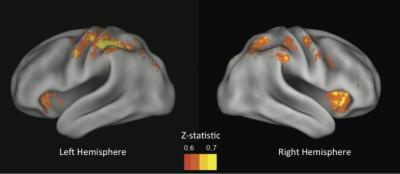A new paper correlates brain activity with how people make decisions.
Based on these images, the authors suggest that when individuals engage in risky behavior, such as drunk driving or unsafe sex, it's not because their brains' desire systems are too active, but because their self-control systems are not active enough.
Defense lawyers now have a new way to make criminal behavior exculpatory. Unless the judge knows something about the weaknesses of inferring cause and effect based on magnetic resonance imaging (MRI) and read this article about how mainstream media love weak observational studies because they make for catchy headlines.
Psychologists analyzed data from 108 subjects who sat in an MRI scanner while playing a video game that simulates risk-taking, called the Balloon Analogue Risk Task (BART) that past papers have used to correlate self-reported risk-taking such as drug and alcohol use, smoking, gambling, driving without a seatbelt, stealing and engaging in unprotected sex.
While playing the BART, the subject sees a balloon on the screen and is asked to make either a risky choice (inflate the balloon a little and earn a few cents) or a safe choice (stop the round and "cash out," keeping whatever money was earned up to that point). Sometimes inflating the balloon causes it to burst and the player loses all the cash earned from that round. After each successful balloon inflation, the game continues with the chance of earning another standard-sized reward or losing an increasingly large amount.

When these brain regions (mostly associated with control) aren't active enough, we make risky choices. Z-statistic corresponds to predictive ability, yellow being the most predictive regions. Credit: Sarah Helfinstein/U. of Texas at Austin.
They say many health-relevant risky decisions share this same structure, such as when deciding how many alcoholic beverages to drink before driving home or how much one can experiment with drugs or cigarettes before developing an addiction.
The data for this study came from the Consortium for Neuropsychiatric Phenomics at UCLA, which recruited adults from the Los Angeles area for researchers to examine differences in response inhibition and working memory between healthy adults and patients diagnosed with bipolar disorder, schizophrenia, or adult attention deficit hyperactivity disorder (ADHD). Only data collected from healthy participants were included in the present analyses.
The scholars then searched for patterns of activity across the whole brain that preceded a person's making a risky choice or a safe choice in one set of subjects. Then they asked the software to predict what other subjects would choose during the game based solely on their brain activity. The software accurately predicted people's choices 71 percent of the time.
"These patterns are reliable enough that not only can we predict what will happen in an additional test on the same person, but on people we haven't seen before," said Russ Poldrack, director of UT Austin's Imaging Research Center and professor of psychology and neuroscience.
When the researchers trained their software on much smaller regions of the brain, they found that just analyzing the regions typically involved in executive functions such as control, working memory and attention was enough to predict a person's future choices. Therefore, the researchers concluded, when we make risky choices, it is primarily because of the failure of our control systems to stop us.
"We all have these desires, but whether we act on them is a function of control," says Sarah Helfinstein, a postdoctoral researcher at UT Austin and lead author, who says that additional research could focus on how external factors, such as peer pressure, lack of sleep or hunger, weaken the activity of our brains' control systems when we contemplate risky decisions. "If we can figure out the factors in the world that influence the brain, we can draw conclusions about what actions are best at helping people resist risks."
Published in the Proceedings of the National Academy of Sciences.




Comments